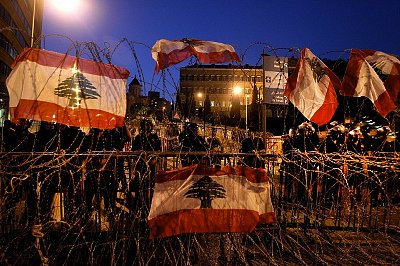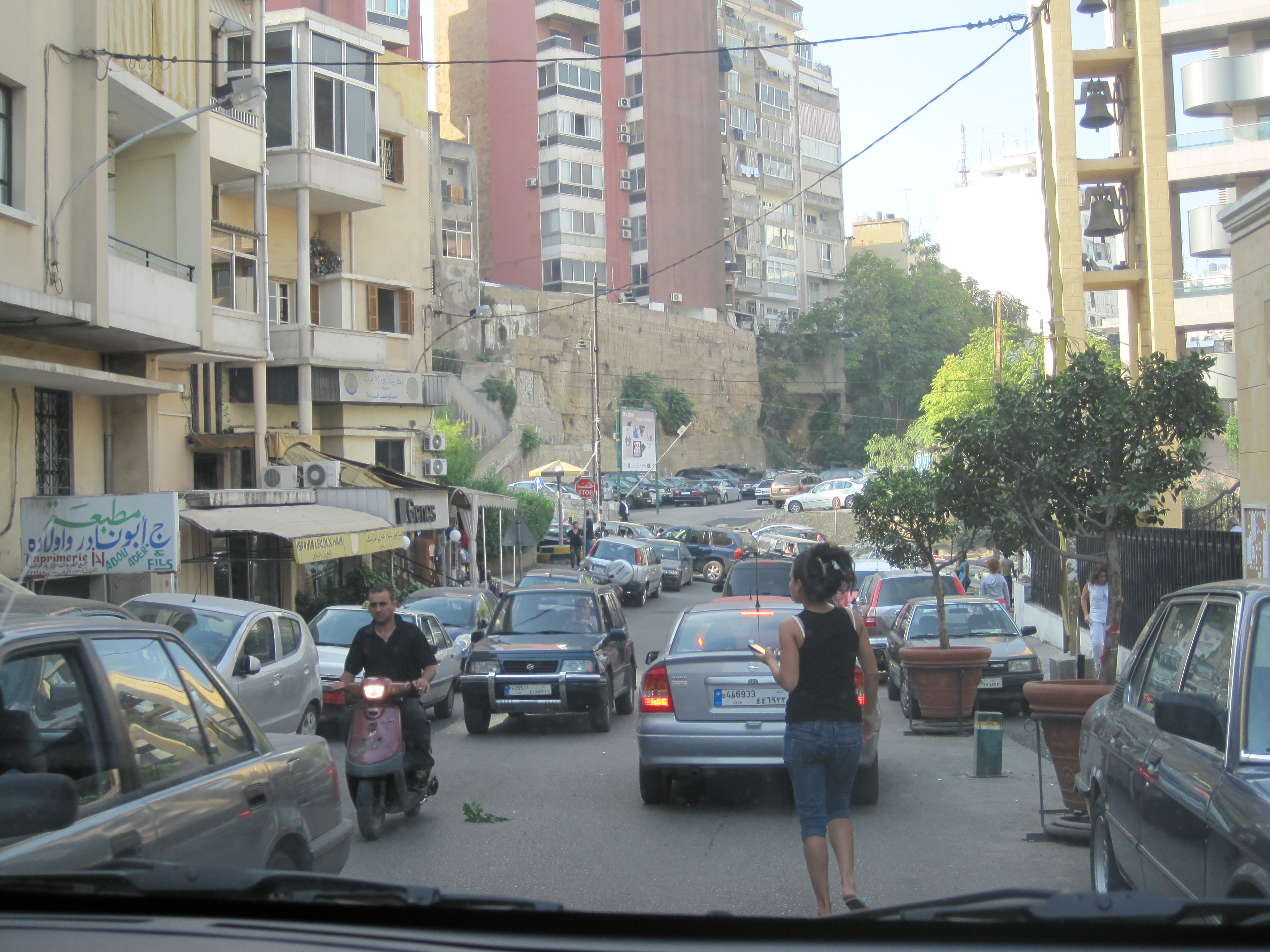
Lebanese anti-riot soldiers protect the Lebanese Government Palace in Beirut following the October 19 bomb blast. Photo by © NABIL MOUNZER/epa/Corbis.
Part 1: Embattled Neighbors
By Irina Papkova
This is the first of two posts from Lebanon in the aftermath of a car bomb that ripped through a Beirut neighborhood on October 19th.
For a tense week in October 2012, just before the terrible ravages of Hurricane Sandy, the attention of the international media focused laser-like on the tiny state of Lebanon. The reason for the media interest that week was sadly familiar to anyone following recent events in the Middle East. On Friday, October 19, a car bomb exploded just meters off a popular commercial square in Achrafiye, a predominantly Christian neighborhood in Beirut. A few hours later it emerged that the bomb had targeted one of Lebanon’s top security chiefs, head of police intelligence General Wissam al-Hassan, killing him and at least two other people. Coverage by CNN, BBC and other news outlets framed the tragedy as yet another incident of sectarian strife in Lebanon, and as evidence of Syria’s civil war spreading onto Lebanese territory.
The media emphasis on a potential civil war has some basis in reality. The relationship between Lebanon and Syria is intricate and complicated, and the chaos in the latter does present serious challenges for its tiny neighbor to the west.
Historically, Syria and Lebanon were ruled for centuries by the Ottoman empire; after the collapse of the Ottomans in 1918, the French moved in and imposed their rule over both Damascus and Beirut in what was known as the French Mandate. The borders within the French Mandate – and the identities of the people that inhabited them – were extremely fluid until the 1940s. In the aftermath of World War II, Syria and Lebanon emerged as independent countries as part of the post-war decolonization process. Yet even then, the politics of the two countries remained intertwined.
In 1976, the Syrian army entered Lebanon on the request of one of the armed factions in the civil war that began in Lebanon in 1975. After the civil war ended in 1991, the Syrian army remained. The occupation of Lebanon allowed the Syrians to dictate foreign policy and a substantial portion of domestic politics in that country for fourteen years after the end of the civil war. The Syrians withdrew only in 2005, in the wake of demonstrations sparked by the assassination of Lebanon’s popular ex-prime minister Rafik Hariri, an outspoken Sunni Muslim politician who was seen as acting contrary to Syria’s interests. Even though the Syrian government ordered its troops to pull out of Lebanon in 2005, it did not dismantle the well-developed network of Syrian intelligence agents in that country, and continued to meddle in its domestic politics by maintaining relationships with influential Lebanese politicians and arranging for the assassination of several anti-Syrian figures.

People on the streets of Beirut shortly after the bomb struck nearby Achrafiye neighborhood. Photo by Irina Papkova, October 19, 2012. Some rights reserved.
The ties between Lebanon and Syria are by no means only political. As mentioned previously, both countries had once been part of the same geographical space under the Ottomans. As late as the first half of the twentieth century, national categories such as “Lebanese” or “Syrian” had little meaning, with family, tribal and religious ties having much more weight. These non-national ties spread like a web across the two countries, with many Syrians having relatives in Lebanon in vice versa. The sectarian and tribal networks are similarly diffuse. For example, the Orthodox Church in Beirut owes its ecclesiastical allegiance to the patriarch of Antioch, who is based in Damascus but has several summer residences in the Lebanese mountains. The same level of interconnection can be found among the other sects, particularly the Sunni, Shiite, Druze and Alawites.
Finally, Damascus is only fifty kilometers from Beirut, facilitating strong economic ties between the two countries. Even today, Lebanese and Syrian citizens move freely between the two countries with a common identity card that is recognized by both sides. In other words, despite the withdrawal of the occupying Syrian army, the ties between the two countries have remained so strong that it is at times difficult to pinpoint where Syria ends and Lebanon begins.
Given these interconnections, it is not surprising that Syria’s ongoing chaos has raised concerns about a possible spill over into Lebanon. Doomsayers point to two possible scenarios. The first has to do with the unfortunate reality that Syria’s war is now being fought on increasingly sectarian lines. It predicts that because Lebanon’s religiously divided population is closely tied to Syria through tribal and religious networks, the Syrian violence will inevitably cause Lebanon’s sects to turn on each other. For example, the regime of Bashar al-Assad is supported by the Alawite population in Syria. Lebanon has a significant Alawite minority living in the north of the country, near the Syrian border. The opposition in Syria is largely Sunni. Lebanon has a large Sunni population. It would therefore not be surprising if Lebanon’s Sunnis turn on the Alawites. And indeed, the northern Lebanese city of Tripoli has seen episodes of violence over the past year, in which Sunni supporters of Syria’s opposition have clashed with Alawite supporters of al-Assad.
The second scenario predicts that Bashar al-Assad will utilize Syria’s remaining spy network in Lebanon in order to destabilize that country and strengthen his own position within Syria. This scenario has its roots in Lebanon’s domestic politics. In 2005, the murder of Rafik Hariri led to the creation of a political bloc opposed to Syrian dominance over Lebanon. Known as “March 14th,” this bloc is composed of eighteen political parties and headed by Rafik Hariri’s son Saad Hariri. The coalition held sway over the cabinet of ministers until January 2011, when it was replaced by a cabinet controlled by a rival alliance of fourteen parties, known as the “March 8th” alliance. Broadly speaking, the “March 8th” coalition is usually seen as representing the interests of pro-Syrian forces within Lebanon, while the “March 14th” bloc oppose them. The second scenario predicts that the Syrian government has and will continue to engage in provocations within Lebanon, meant to spark a civil war between the followers of March 8th and March 14th.
The assassination of Wissam al-Hassan plays into both of these predictions. al-Hassan was a prominent member of the Sunni community and had in the past been in charge of security for Rafik Hariri. He had spearheaded the investigation into Hariri’s assassination, which is broadly believed to have been carried out by Hezbollah at the request of the Syrian government. al-Hassan was open in his condemnation of the Syrian regime’s brutality since the beginning of Syria’s civil war. More importantly, in September 2012 al-Hassan’s security agency had outed a spy ring allegedly led by a prominent “March 8th” politician, Michel Samaha. The spy ring was linked to the Syrian government, and was accused of bringing explosives into Lebanon with the intent of destabilizing the country. Thus, al-Hassan’s assassination was immediately interpreted by many observers as Bashar al-Assad’s revenge and a warning to those “March 14th” Lebanese who may sympathize with the Syrian rebels. It was also interpreted as an act of violence directed specifically at the Sunni community.
The fears that the car bombing would lead to civil war were compounded over the weekend immediately following the assassination. On Saturday, October 20, angry Sunni protesters blocked roads across the country with burning tires. The next day, the funeral of General al-Hassan ended in violence, as a crowd of about five hundred angry young men – mostly Sunni – attempted to storm the government offices in downtown Beirut. Carrying sticks and rocks, they attacked the army posts outside the imposing building housing the prime minister’s office, demanding the replacement of the “March 8th” government by one led by the anti-Syrian “March 14th.” The weekend as a whole was marked by shoot-outs in several Beirut neighborhoods, as the army squared off with Sunni militants armed with RPGs. In Tripoli, Lebanon’s second largest city, clashes between Sunni and Alawite neighborhoods resulted in at least three deaths. For a tense seventy-six hours, Lebanon appeared to be poised on the edge of an abyss.
Irina Papkova is a Research Fellow at Georgetown University’s Berkeley Center For Religion, Peace and World Affairs. She received her Ph.D. from Georgetown University and has previously taught at Georgetown and George Washington Universities. Her book, “The Orthodox Church and Russian Politics,” was published by Oxford University Press and Woodrow Wilson Center Press in 2011. Irina’s current research includes Lebanese politics and the Secular Lebanon movement. She is a regular contributor to The Revealer.
With support from the Henry R. Luce Initiative on Religion and International Affairs.

